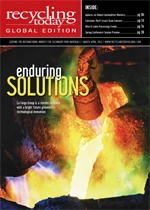 Few modern companies can claim a lineage that dates back more than 200 years, making La Farga Group rare among its peers. The history of this family-owned Catalonian holding company dates back to 1808 and the formation of La Farga Lacambra (LFL), which produces and sells semi-finished copper products made from recycled copper.
Few modern companies can claim a lineage that dates back more than 200 years, making La Farga Group rare among its peers. The history of this family-owned Catalonian holding company dates back to 1808 and the formation of La Farga Lacambra (LFL), which produces and sells semi-finished copper products made from recycled copper.
More recently, La Farga Group has expanded to include La Farga Tub (LFT), which makes, sells and distributes copper pipe and tube for industrial applications; La Farga Rod (LFR), which makes electrolytic copper rod from high-grade cathodes; and La Farga Intec (LFI), which develops and sells technology with Continuus Properzi Spa.
In addition to these business divisions, in 2004 La Farga Group established La Farga Foundation, which operates a copper museum at the group’s headquarters in Les Masies de Voltregà, Spain, about an hour outside of Barcelona. That site also is home to LFL, LFR and LFT. La Farga Foundation also funds the university education of company employees and needy residents of the town.
While La Farga Group is relatively young, having been established in 2003, its origins can be traced back 200 years to the growth of LFL.
Port of Origin
LFL traces its lineage back to 1808, when Francesc Lacambra i Pont established a small foundry in the Barceloneta port district of Barcelona. Francesc also traded used copper generated from replacing sheeting used on the hulls of sailing ships, becoming one of the primary suppliers to the Barcelona Royal Mint by 1844.
In 1852 Francesc launched La Farga Lacambra, a water-driven foundry along the Ter River in Les Masies de Voltregà. The foundry began producing copper sheeting in 1853 under the direction of Francesc’s son Joan Lacambra Pujadas. The Spanish Navy was among the company’s customers, says Marc Gascón, who purchases raw material for La Farga Group. LFL even supplied the copper sheeting for the Spanish ships that sailed to America, he adds.
Continuing the company’s culture of expansion, Francesc’s son Josep Lacambra Saborit led a retooling of the foundry’s machinery, enabling LFL to begin production of wire rods for electric cables in 1913. This move expanded the company’s customer base to include the electrical and railway industries, according to La Farga Group.
 Innovative Approach
Innovative Approach
In 1986, LFL became the first company to produce thermal rods for continuous casting using No. 2 copper scrap containing 94% or more copper, Gascón says. The company’s patented Cosmelt Process is a pyrometallurgical method that reduces the number of stages required to recycle copper scrap. While other methods require a total of three production phases (via an electrolytic process), LFL says it can complete the entire process in one stage.
The Cosmelt Process is environmentally superior to other methods as well as more efficient because it eliminates the need to first produce anodes and cathodes, LFL says. Additionally, the company’s refining process uses a special furnace that can improve the purity of the copper to 99.6%.
“Our main strength is this technology,” Gascón says, adding that LFL can produce copper wire with a level of purity comparable with that of wire made from copper cathodes.
LFL’s Cosmelt technology has been sold to more than 28 plants in 15 countries worldwide, according to Carme Sáez, corporate development director at La Farga Group. “Continuus Properzi sells the machinery, and we sell the know-how.”
LFL has the flexibility to consume No. 1 copper scrap in addition to No. 2 copper, Gascón says. The company purchases loose copper scrap from within Europe as well as baled material from the United States. LFL also sources scrap from South America.
 LFL produces semi-continuous and continuous castings that are used to make semi-manufactured products, such as wire, billet, cable, cord, multi-strand wire, rigid wire and pipe. The company has branded the copper it produces from recycled metal Ecocopper.® LFL says its Ecocopper products can be used to manufacture high-, medium- and low-voltage cables; data transfer, control and instrumentation cables; cables for the telecommunications industry; cables for the automotive industry; short circuit links; contacts and plates; supports for superconductive materials; wires for welding metal containers; pipes for water, gas and heating ducts; pipes for cooling and technical gases; copper wire rods; profiles and applications in galvanisation.
LFL produces semi-continuous and continuous castings that are used to make semi-manufactured products, such as wire, billet, cable, cord, multi-strand wire, rigid wire and pipe. The company has branded the copper it produces from recycled metal Ecocopper.® LFL says its Ecocopper products can be used to manufacture high-, medium- and low-voltage cables; data transfer, control and instrumentation cables; cables for the telecommunications industry; cables for the automotive industry; short circuit links; contacts and plates; supports for superconductive materials; wires for welding metal containers; pipes for water, gas and heating ducts; pipes for cooling and technical gases; copper wire rods; profiles and applications in galvanisation.
Sáez says the products produced by the various companies under La Farga Group’s umbrella are generally sold within a 1,500-kilometre radius of the manufacturing plants, given their weight. However, she continues, “We have markets around the world and are always looking to diversify our markets.” Sáez adds that La Farga Group is interested in developing markets outside of its home region, noting the European debt crisis and the downtrodden Spanish economy. North Africa, for example, has been a growing sales region, Gascón says, helping La Farga Group to remain unaffected by the economic downturn in parts of the European Union.
Sáez says La Farga Group’s focus on research and development is the reason it has survived for more than 200 years. “We are continually investing in new technologies and in research and development in order to adapt ourselves to the market.” She adds that La Farga Group also has continually sought to diversify its operations and products, taking cues from the needs of its clients.
Upon a Solid Foundation
LFL accounts for the largest share of La Farga Group’s sales in terms of tonnage. LFL sold in excess of 93,300 tonnes for the year through September of 2011, Sáez says. During that same time, LFR, which was established in 2008 on the site of La Farga Group’s headquarters in Les Masies de Voltregà and specializes in the production of copper wire from cathodes, sold nearly 88,000 tonnes.
LFT was formed in 2006 when La Farga Group grew its share in Tubo Técnico Europeo from 36% to 86%, and the company changed its name. In September 2011, La Farga Group formed La Farga Tub France in Lyon, which distributes tubes manufactured by LFT to the French market. LFT sold slightly more than 15,000 tonnes through September of 2011. LFT products are used in plumbing, heating, air conditioning and refrigeration.
“Each of these companies is operated independently,” Gascón notes. “La Farga Group is a stakeholder, but they each have their own purchasing departments and management.”
In 2010 La Farga Group established a joint venture in the Chinese city of Ganzhou, known as Ganzhou Jiangwu – La Farga High Speed Railway Copper Materials, with a private partner and the government of the Chinese province of Jiangxi. The company manufactures a range of products for railway electrification for the country’s high-speed rail industry.
In 2011 La Farga Group announced a second joint venture in the United States with Steel Dynamics, headquartered in the U.S. city of Fort Wayne, Indiana. The joint venture, SDI La Farga LLC, is building a secondary copper smelter in Indiana to produce copper wire products exclusively from copper scrap. The plant is scheduled to become operational in April of this year and will consume copper scrap purchased on the open market.
Sustainable Future
Sáez says the family behind La Farga Group is not interested in developing the company for sale to one of its many multinational competitors. Instead, she says, the family wants to develop a company that is sustainable in the long term, which includes being environmentally and socially responsible.
She adds, “The mission is to be a leader in copper recycling and in the development of high-performance copper materials.”
Innovation is a key factor in maintaining the company’s leadership position, Sáez says. “We have the spirit of improvement,” she says of La Farga Group. “We are always trying to improve.”
The author is managing editor of the Recycling Today Media Group and can be reached at dtoto@gie.net.

Explore the April 2012 Issue
Check out more from this issue and find your next story to read.
Latest from Recycling Today
- BlueScope, BHP & Rio Tinto select site for electric smelting furnace pilot plant
- Magnomer joins Canada Plastics Pact
- Out of touch with reality
- Electra names new CFO
- WM of Pennsylvania awarded RNG vehicle funding
- Nucor receives West Virginia funding assist
- Ferrous market ends 2024 in familiar rut
- Aqua Metals secures $1.5M loan, reports operational strides





